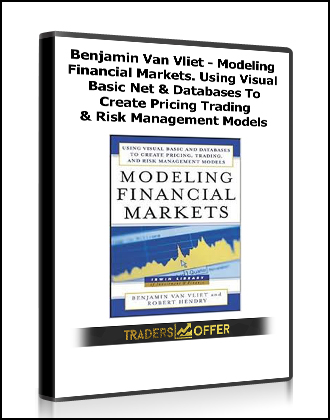
Benjamin Van Vliet – Modeling Financial Markets. Using Visual Basic Net & Databases To Create Pricing Trading & Risk Management Models
Price: $25
Please contact us: – Email: Tradersoffer@gmail -Skype: [email protected]
Benjamin Van Vliet – Modeling Financial Markets. Using Visual Basic Net & Databases To Create Pricing Trading & Risk Management Models
Development Financial markets professionals today must sort, analyze, and act upon incredible amounts of data. This has led to increasing reliance on computer-based risk management models. Limitations in popular software packages for financial modeling system development, however, can threaten the viability of any system – not to mention the firm using that system. “Modeling Financial Markets” takes traders and money managers beyond those limitations by helping them design more consistent, sophisticated, and versatile modeling methods.This high-level, hands-on book features: guidelines for maneuvering around the Visual Basic; .NET integrated development environment (IDE) and customizing it to improve your development efficiency; dozens of innovative and useful techniques for financial modeling in code that minimize or avoid current software deficiencies; and, an approach for delivering an evaluation and specification prototype in Excel, one that is scalable into either VB.NET or another implementation language.The need for complex yet usable financial modeling systems has never been greater. Let “Modeling Financial Markets” help you progress beyond static modeling programs to more sophisticated system development processes, then implement those processes in your actual trading methodology. ‘In a sense, this book marries four disciplines – computer science, quantitative finance, trading strategy and quality development – into one, financial engineering. It is about modeling financial instruments in code and putting the pieces, or models, together to create an automated trading or risk management system. Let’s get started…’ – From the Introduction.Human traders – using strategies that combine technical and fundamental indicators with gut instincts and market savvy – are quite possibly an endangered species. They are being replaced by quantifying trading systems capable of watching hundreds of securities and derivatives simultaneously and, at the exact second that conditions are most favorable, executing hundreds of strategies in a millisecond. These systems, however, must still be designed and constructed by financial engineers. “Modeling Financial Markets” is today’s most in-depth exploration of the Visual Basic, .N ET programming concepts that relate to research, testing, and implementation of pricing models, trading systems, and risk management systems. It provides innovative techniques for overcoming systemic shortcomings in Excel/VBA, along with insights and guidelines for managing the crucial, sink-or-swim crossover stage when prototypes are converted to fully coded models.Virtually every vital tool needed to construct and implement a quantitative trading or risk management system is detailed, providing you with a basic understanding of: Visual Basic, .NET relational database design; Structured Query Language (SQL); Extensible Markup Language (XML); Financial industry protocol FIXML; Object Oriented programming (OOP); Application Programming Interfaces (API) for optimization API for market data feeds, trade entry, and trade fill information; Objects and collections to clean data; In sample/out of sample testing; code for matrix algebra and multiple linear regression.Modeling financial markets builds several important financial topics from the ground up, and always places the emphasis on the implementation of systems in actual trading situations and arenas. Sophisticated yet written and arranged for easy understanding and implementation, it is the first book to take finance professionals beyond the limitations of today’s software and processes to introduce safer, more effective, and more accurate financial modeling methods.

